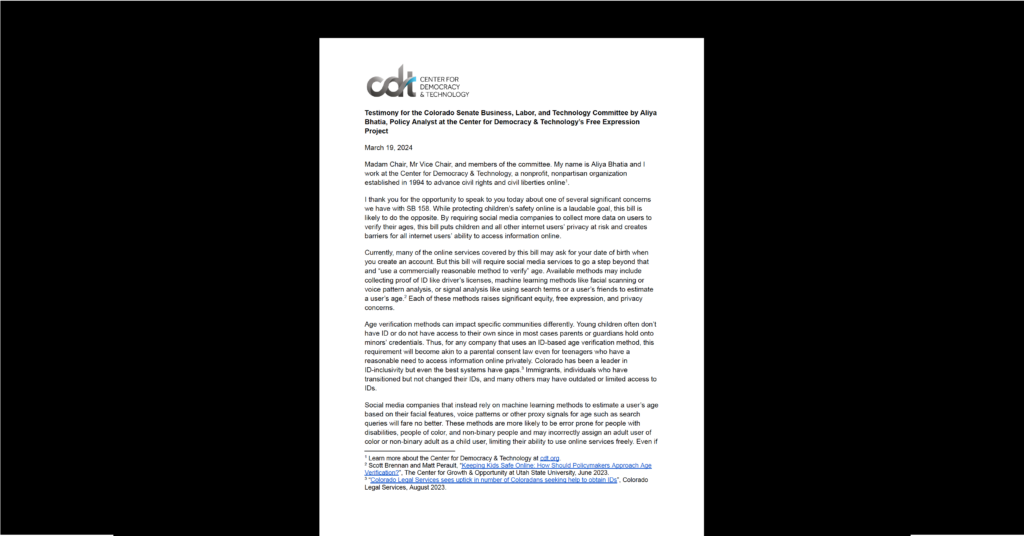Leslie Harris, MySpace: Coming of Age for Coming of Age, ABC News, Feb. 28, 2008
Serious questions are being raised about how to control minors’ access to online social networking sites. In an effort to forestall pre-emptive legal or legislative solutions, MySpace.com last month announced an agreement with 49 state attorneys general to convene a task force to investigate the issue and make recommendations.
Chief among the solutions the task force will explore are various age verification technologies. Such technologies are supposed to be nonblinking gatekeepers, automatically shutting off access to certain sites if the would-be user is underage, or keeping adults out of areas intended for minors.
Details of the task force were unveiled this week. The Berkman Center for Internet and Society at Harvard Law School will lead the effort, which includes many leading Internet companies and child safety experts. The organization that I lead, the Center for Democracy and Technology, will participate as well, albeit with a healthy dose of skepticism.
Age verification not only raises difficult technical questions, it raises a host of legal and policy questions that have sweeping implications for the future of the Internet and its millions of users worldwide. To be legitimate, the task force, which will make a final report at the end of the year, must not only ask if we can build age verification technology that works, but should we?
What’s the Problem?
The first question that must be asked is, what is the problem that needs to be solved? Is age verification intended as a response to public concerns about risks to children posed by online predators?
While such predators are an important law enforcement concern, just last week the nation’s leading academic researchers — to use their word — “debunked” the public’s assumptions about online safety.
“Adolescents’ use of popular social networking sites, such as MySpace and Facebook, do not appear to increase their risk of being victimized by online predators,” according to the Crimes Against Children Research Center at the University of New Hampshire.
The task force must put the hype aside and target the social problem in order to decide whether age verification technologies are or could be the most effective solution. Is the goal to prevent minors from using social networking sites? Is it to prevent adults from participating in sites aimed at minors? Is it to limit minors’ access to content intended for adults, or to encourage them to value and protect their privacy?
Is the problem that social networking is somehow inherently dangerous to young people, warranting their wholesale exclusion? This seems unlikely in light of the role that social networking plays in offering a platform for creativity and self-expression, collaboration and community building.
Young people use social networking for more than just keeping in touch with their friends. They use the sites to organize support for political candidates, build support for favorite charities, and provide support to friends and family fighting in Iraq and Afghanistan.
Or is it more simply that the generation that has grown up online has a cavalier attitude toward its own privacy and that of its peers, and little understanding of the potential consequences of posting the details of their lives in cyberspace?
There is already a broad array of technology tools and techniques that parents can use to protect their children from unwanted content and contacts, and a variety of well-regarded Internet literacy programs to guide young people online. It is vital to assess how age verification for social networking would fit — if at all — into the existing landscape.
Beyond Age Verification
Beyond these critical threshold questions, there are a number of important specific questions that a task force must consider with regard to any age verification or authentication technology:
First, how effective is the technology, and how easy would it be to evade? And if a site invests in an age verification system, what prevents minors from simply moving to another site without such restrictions — a site perhaps out of the country and beyond the influence of the state attorneys general.
The costs of a new technology will have to be borne either by users or providers, so it’s important to honestly assess whether the benefits are worth the costs.
Second, can age verification and identity technologies work, given the global reach of the Internet? Social networking sites attract users from around the world. If the verification depended on access to U.S. databases, such as state motor vehicle agencies, would sites effectively be forced to become “U.S.-only,” or otherwise dependent on country-specific requirements?
Third, can we verify age or identity and still protect privacy? Would personal information about minors have to be submitted and maintained in large databases, or would Internet users have to have an authenticated identification card to go online?
Fourth, how do we preserve free speech rights if minors are excluded from social networking sites? Minors — especially older minors — have constitutional rights to communicate, even against the wishes of, or without the knowledge of, their parents. And if age verification becomes a legal mandate, would it pass constitutional muster?
Legal and Policy Issues
Finally, and perhaps most critically, what effect would age verification and identification technologies have on the dynamic and innovative ways that people — minors and adults alike — interact with the Internet? What are the implications of building gatekeepers into the medium and diminishing the ability to remain anonymous? How would such a dramatic shift impact how people relate to and use the Internet? What would that shift mean for the future of the medium?
As the new task force begins its work, it should acknowledge that the scope of its investigation must not begin and end with a search for a workable age verification technology. The legal and policy issues raised by age verification must be considered as well.


